This is one of the biggest games of Manchester City and Pep Guardiola, as they will travel to Santiago Bernabéu. This is not only a stern test for Real Madrid, but Manchester City also have to show their capability to beat the best teams in Europe. They are the contender of Champions League winner, no matter the issues with the UEFA or not.
In the Premier League, they recovered from the loss against Tottenham. Then, they keep two clean sheets against West Ham and Leicester City. Currently, they enjoy a seven-point margin from the third.
We should expect Guardiola comes up with some intriguing tactics to surprise Real Madrid, especially after the winter break in domestic competitions. In this analysis, we first explain the issues that have bothered City throughout the season. Then, we are going to explain why playing in a back three can possibly become a solution. In this tactical analysis, we will try to give you an insight into City’s tactics.
Team news & predicted starting XI of City
City’s key players, Raheem Sterling and Leroy Sané were fighting for fitness due to the injuries. We guess the former has a chance to start but the German still takes time to gain the rhythm. Aymeric Laporte started in the last two games but never complete the full match, but he should be fit to play as well. We choose not to give a formation as the positions of City players are fluid. Even though it could look like a back four on paper, in fact, Guardiola can instruct them to play like a back three.
Starting-11: Ederson; Kyle Walker, Fernandinho, Laporte, Benjamin Mendy; Rodrigo Hernández, Kevin De Bruyne, Bernardo Silva; Raheem Sterling, Sergio Agüero, Riyad Mahrez.
The decline of D. Silva
First, I try to explain the suggestion of leaving David Silva on the bench. The form of David Silva has dropped since the success of the last campaign. Offensively, sometimes his heavy passes will be sent in an appropriate weight in the bygone days. But this is just a small issue. A bigger issue is the intensity of City’s pressing. When D. Silva is a part of the press, he has to sprint more and mark the targets tighter. This season, D. Silva stays on the bench for the whole game at Anfield even City are losing, given there is an English Football League Cup final, Guardiola can consider letting the Spaniard start in another game.
In general, City defend in a 4-4-2, their front players have to shut the passing lanes while pressing the opponent. However, on some occasions, D. Silva let the free player receives the ball without pressure. As a result, this leads to a quality out ball to progress the attack.
As shown in this example, City players do okay to man-mark the Norwich players and compress space (Ilkay Gündoğan – Kenny McLean; B. Silva – Jamal Lewis; D. Silva – Emiliano Buendía). However, when Gündoğan is engaging McLean, D. Silva is still far from Buendía, he allows the Argentine to receive the ball, turn and progress the attack easily. This is an unhealthy situation for City as we all know, the backline of City is fragile since the departure of Aymeric Laporte and departure of Vincent Kompany. The ideal situation is the front players defending on the frontline and reduce the pressure of the defenders.
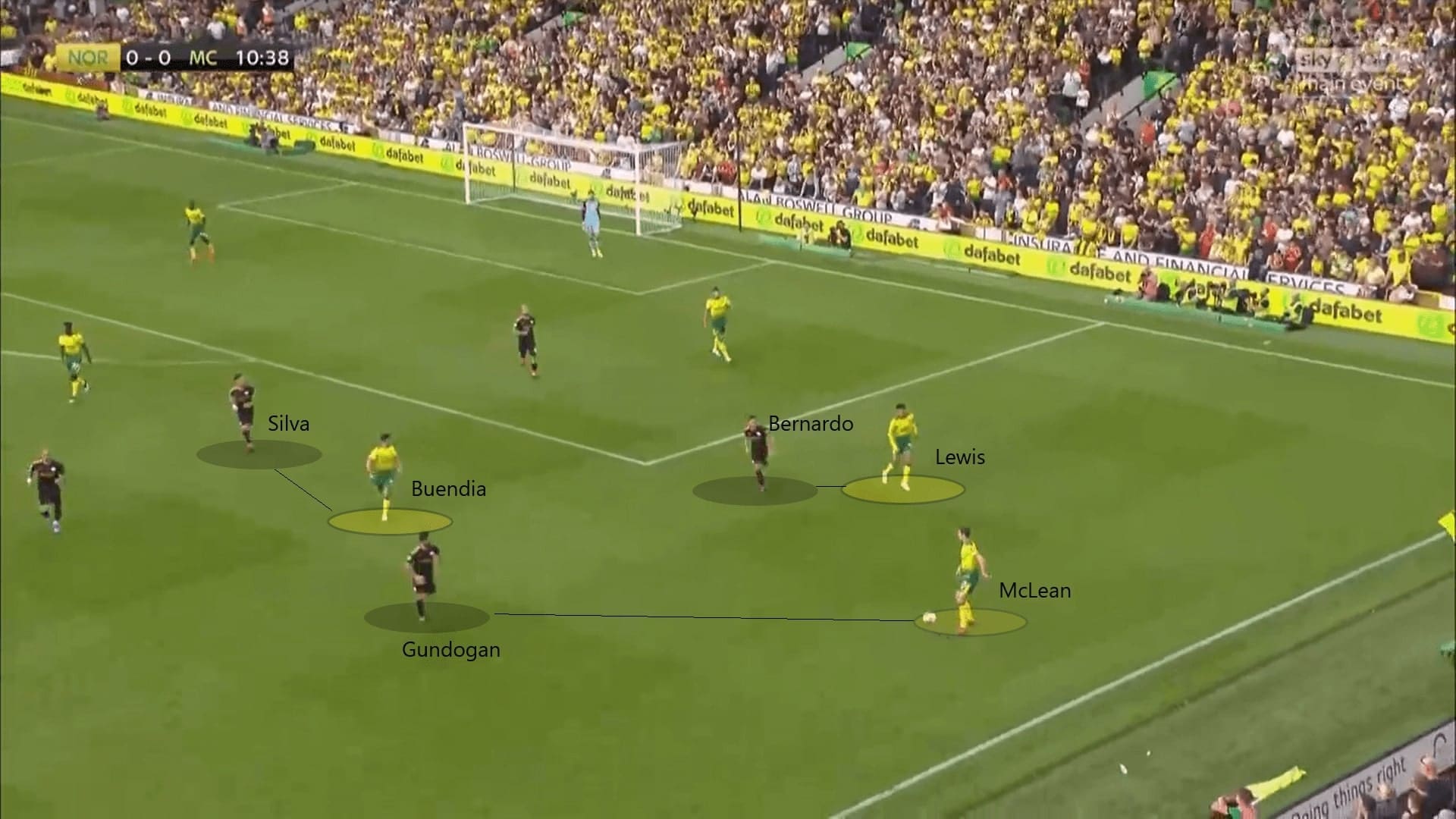
Below is another example. When Gabriel Jesus is engaging at Victor Lindelöf’s back, D. Silva and B. Silva are approaching Fred and Scott McTominay. In this situation, it is not difficult for City to defend as they have sufficient number to man-mark the Red Devils (B. Silva- Fred; D. Silva – McTominay; Sterling – Aaron Wan-Bissaka). However, D. Silva again let McTominay turns and receives the vertical pass from the Swedish easily. United break the press.
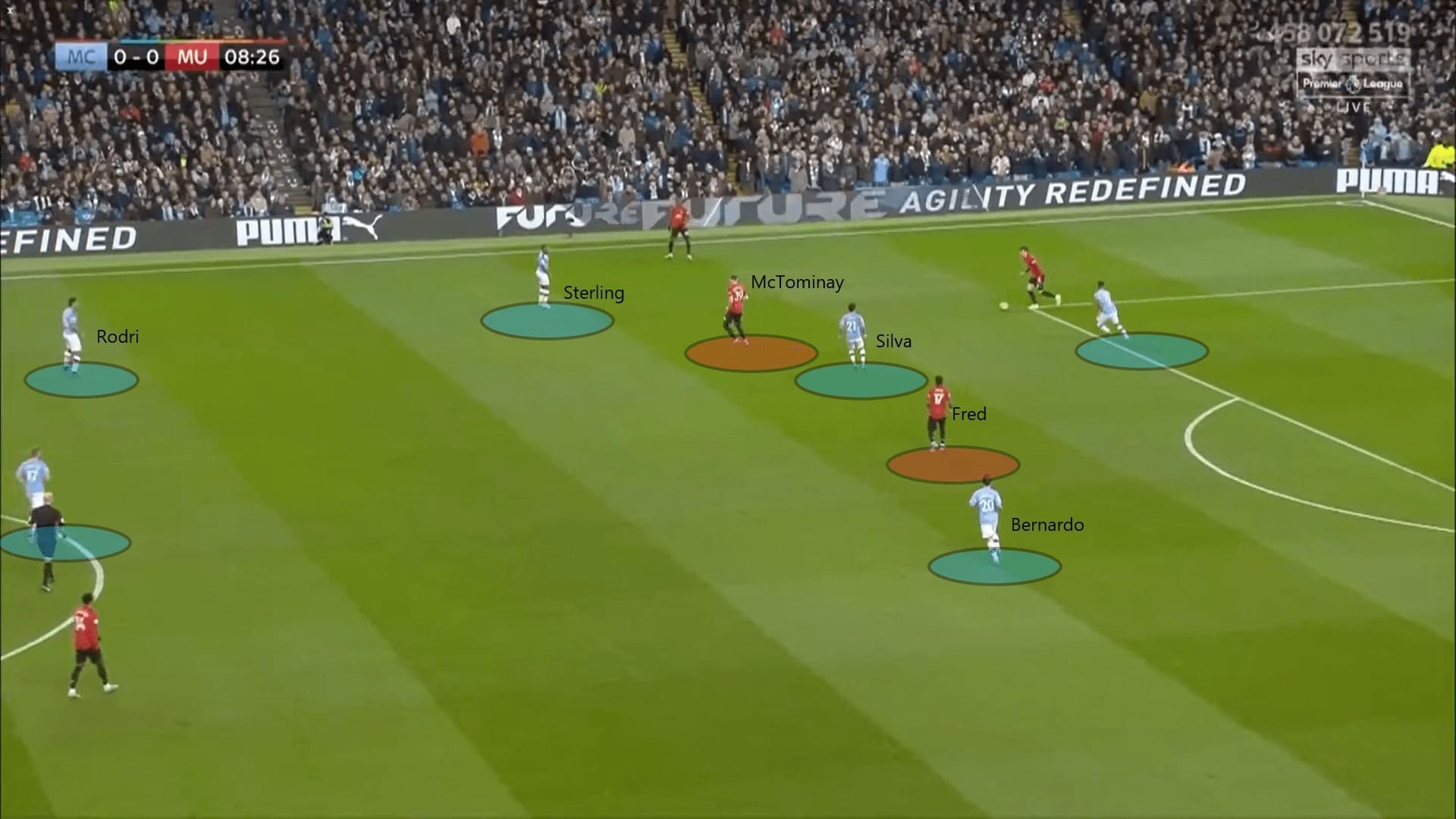
When a back four doesn’t work
City’s defence has been criticized in this season. So far, they concede 0.95 goals per game and an xG against 0.82. These figures for last season are 0.64 and 0.7 respectively. From the individual point of view, missing the key centre-backs is one of the reasons. On the other hand, the structure of City is also a culprit.
The problem is the role of the full-backs. Guardiola is famous for the use of ‘inverted full-backs’, and this becomes a weakness. The oppositions who look to play quick counters against City always target wide areas to start an attack. If the sole pivot cannot interrupt or delay the attack, the centre-backs are left to face the oppositions 1-v-1. On other occasions, the full-backs join the press by leaving his position. If City failed to recover the ball high, the opponents also target the wide areas.
To name but a few, this example is how Jamie Vardy scores at the Etihad. In this case, Walker failed to stop the progression of the transition initially. Harvey Barnes cleverly picks the space behind Walker, the pressure from Gündoğan is too late. On the frontline, Fernandinho is isolated against Vardy, with Barnes’ pinpoint pass to exploit the space behind Fernandinho, Vardy faces Ederson and scores the goal.
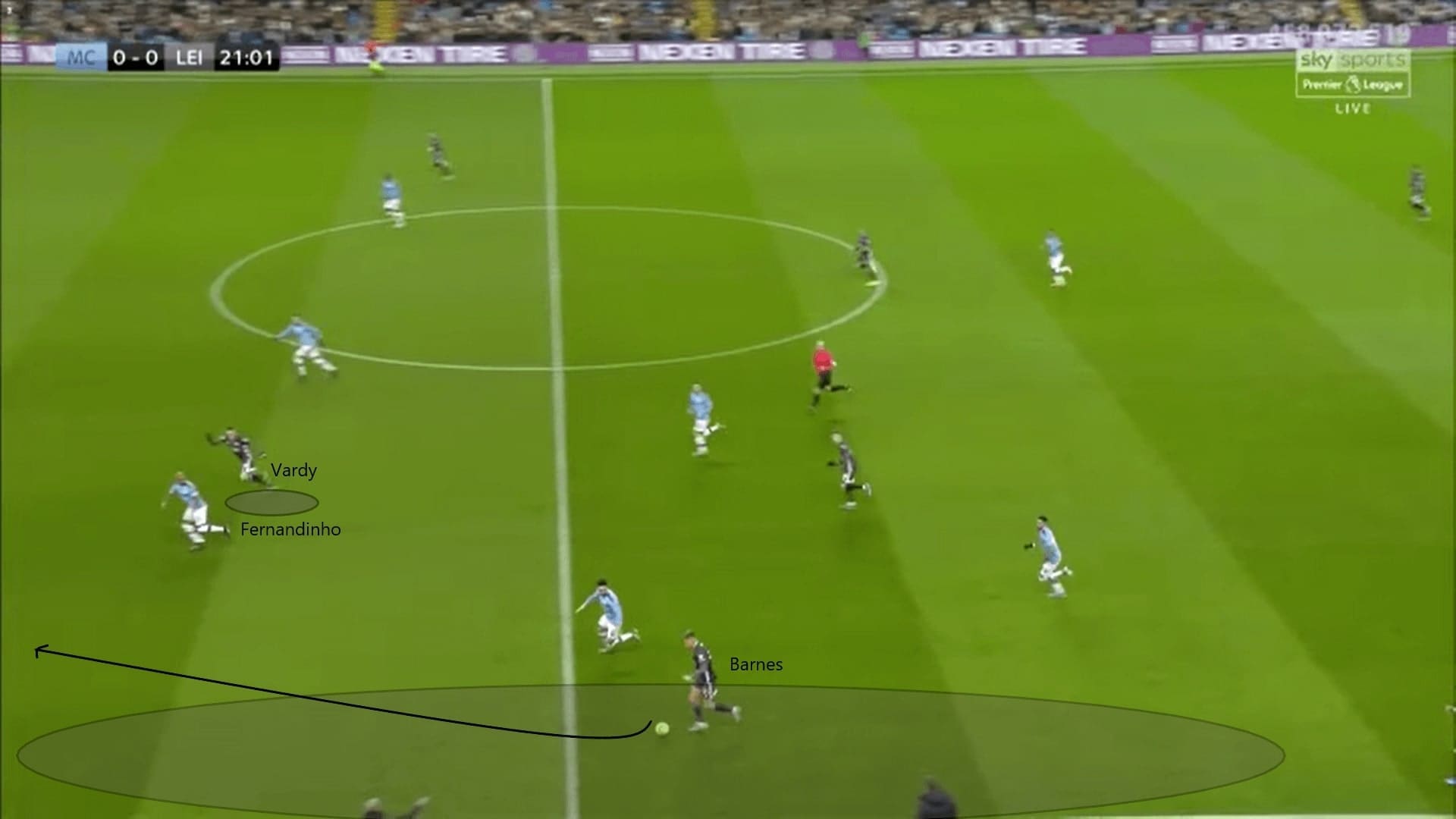
As a sole pivot, Rodri does not defend enough in terms of covering the lines and tracking the opponents. Of course, the Spaniard has a high workload defensively. If he did not track the free player in his own third, the result can be catastrophic.
In this example, we see Liverpool are attacking. In this case, Rodri pays too much attention to the ball carrier, Sadio Mané. He is unaware of the player behind him, which is Georginio Wijnaldum (though Rodri is marking the Dutchman initially). It is dangerous to let a free man attacks the box. They are lucky not to concede a goal, but they cannot guarantee Madrid to waste the chance in such area and condition.
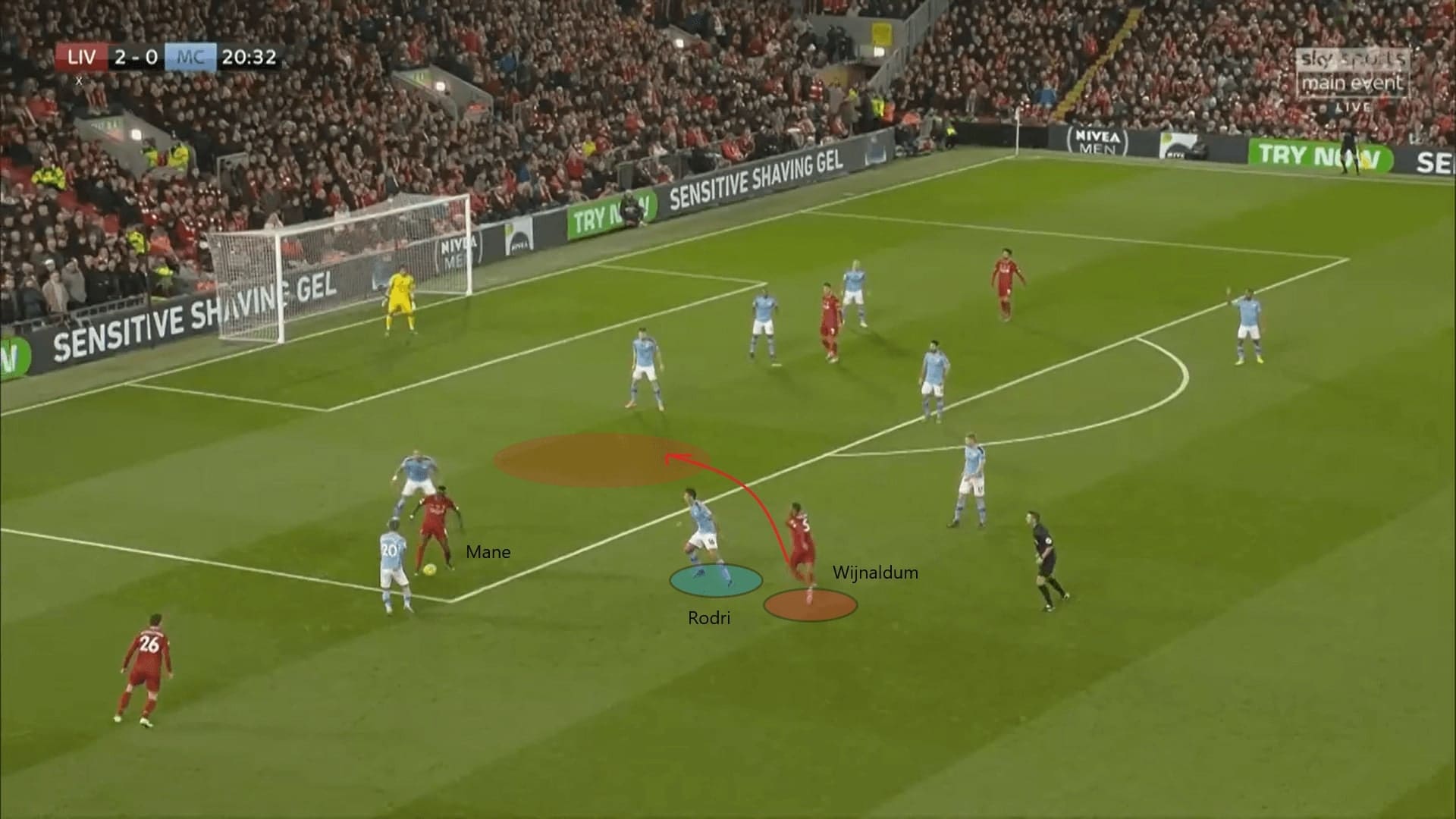
Again, we use another example to illustrate the issue of Rodri. This is a mix of losing concentration and not shutting the passing lane. In this case, when the ball is bouncing to Marcus Rashford, Rodri does not react immediately to pressure him. It is fine, if the Spaniard adjusts his position and body orientation, he can still shut the passing lane to Anthony Martial or even intercept it.
In this scenario, Rodri does not react, merely standing and watch. And, he gives the chance for Rashford to find Martial through the gap between Walker and him.
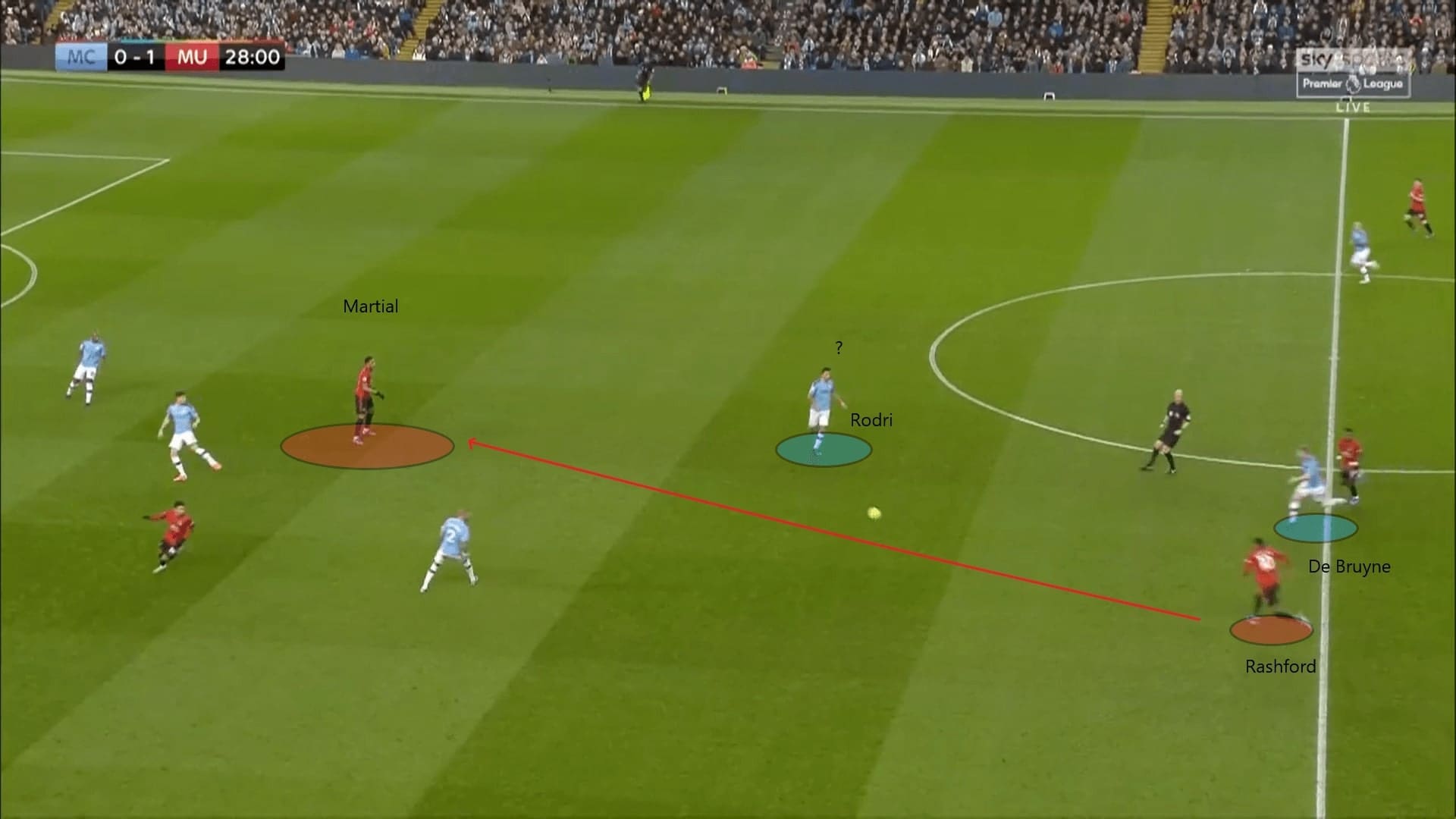
As mentioned, City press in a 4-4-2 shape in general. This also becomes an issue when the press is lacked intensity and compactness. Even though Guardiola played Gündoğan instead of D. Silva in an advanced role, the German also has similar issues. In this example, we see Liverpool are trying to play out from the back. Initially, Gündoğan follows Fabinho pushes himself high. However, when Fabinho gives the ball to Alisson, the German decides to retreat and turn his back to the ball. We cannot understand the decision as Agüero and De Bruyne are tasked to mark the centre-backs. Soon, the Liverpool goalkeeper plays to Fabinho and the sole pivot of Liverpool is free to progress the ball.
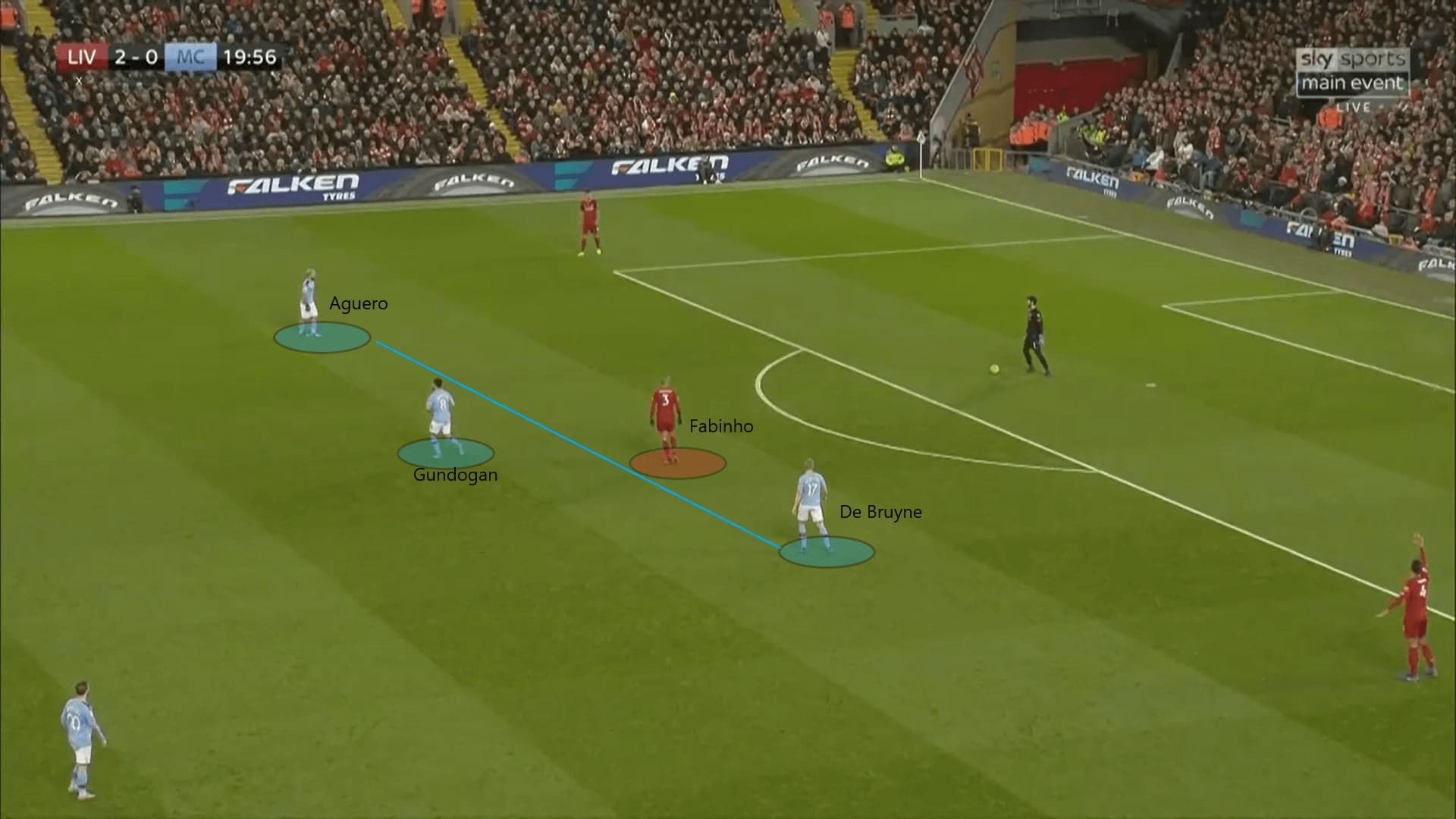
When Rodri and Gündoğan play together, the shape of City is more like a 4-2-3-1. Guardiola intends to give Rodri a partner and shield the midfield with one more man. This move does not give the effect which Guardiola wishes, and somehow their functions and roles are duplicate in this case. Many unfavourable results in this season, including a loss against Wolves, Tottenham and Norwich.
Of course, the loss at Anfield is another example. Adding Gündoğan in the build-up phase and use the full-backs to stretch the pitch is not the best solution. It is because the German tends to opt for a safe option when dealing with pressure. Also, his body orientation is imperfect for most cases. In this case, even without the instant pressure from a red shirt, Gündoğan still opts a backward pass to John Stones. This is not helping the build-up of City.
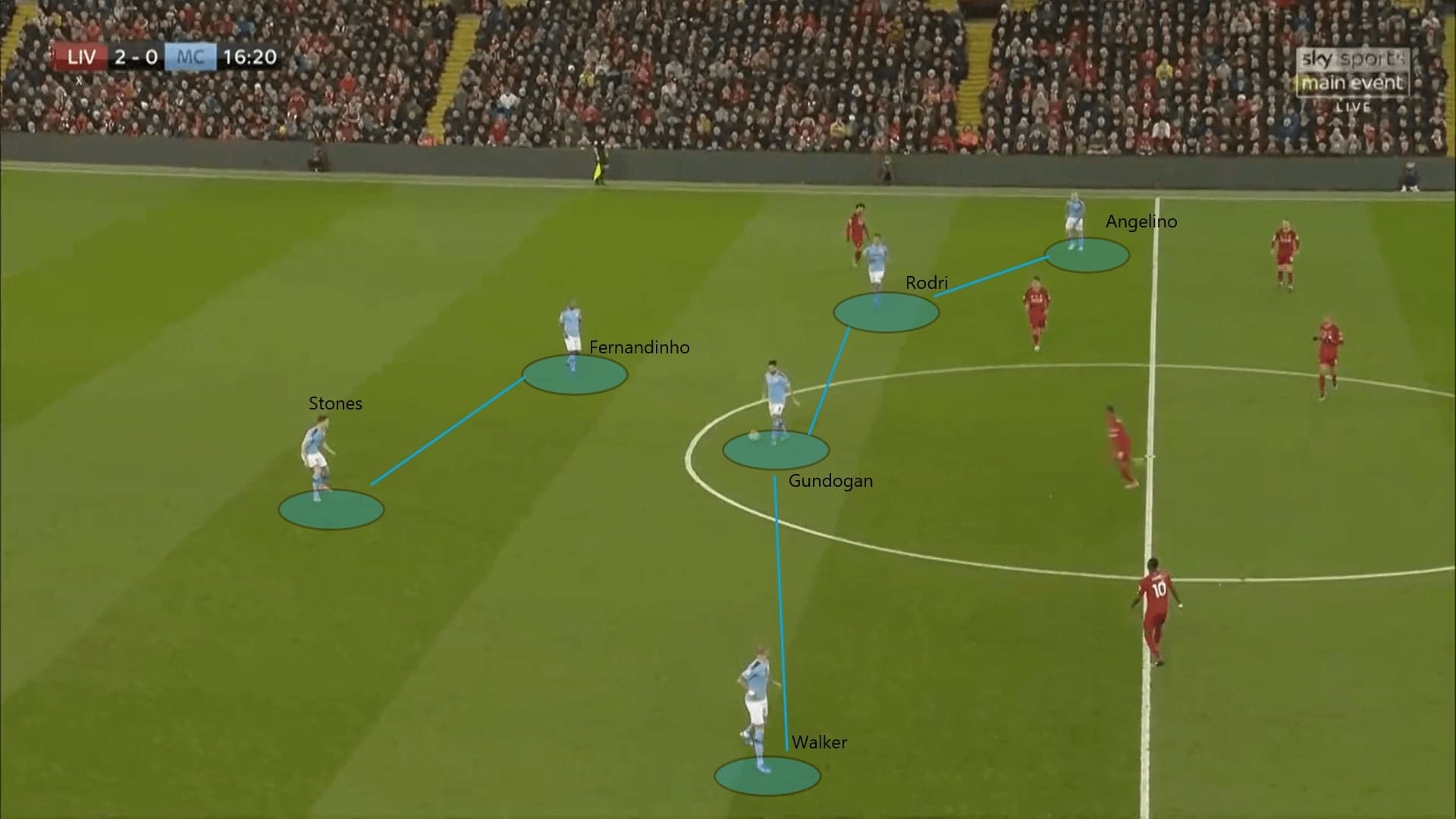
Below is Gündoğan’s pass map against Liverpool. He has a high success rate (95%) as he completes 54 passes out of 57. However, when we break down the types of the pass, only 11 of them forward passes, and only two of them are made in City’s half. 74% of his passes are lateral passes and backward passes. This hints that the presence of Gündoğan might not help City to penetrate at the centre.
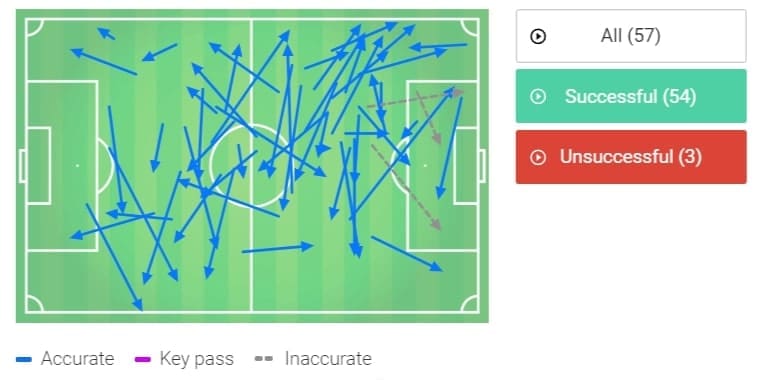
How can City benefit from a back three
Against Madrid, it is too passive and predictable for City to sick in their original style of play. My suggestion is playing Rodri as a centre-back alongside with Fernandinho and Laporte; Walker and B. Mendy play as the wing-backs; De Bruyne and B. Silva become the double pivot; Agüero, Sterling and Mahrez form the front three and enjoy the freedom to roam their positions.
Defensively, no matter what the shape of City’s press is, the main point is the back three. This gives City to spare a wide centre-back to cover the spaces behind the wing-backs. For the midfield, they have one of the most hardworking players, B. Silva at the centre of the pitch to fight to defend and cover. Ideally, the wide centre-back can cover the spaces behind the wing-backs, as Benzema tends to drop and exploit those areas.
When City are defending, they should try to close Madrid at a side and deny the switch plays. With a back three, the spare wing-backs on the weak side can tuck inside flexibly to allow City to shift to a back four, ensuring the numbers at the backline. Also, this allows City to defend the central players with a 4-v-3 situation. For the City players, they have to run a lot to cover the ball side and shut the passing lanes, force Madrid to go long. This also prevented Rodri playing as a sole pivot and being exposed as explained.
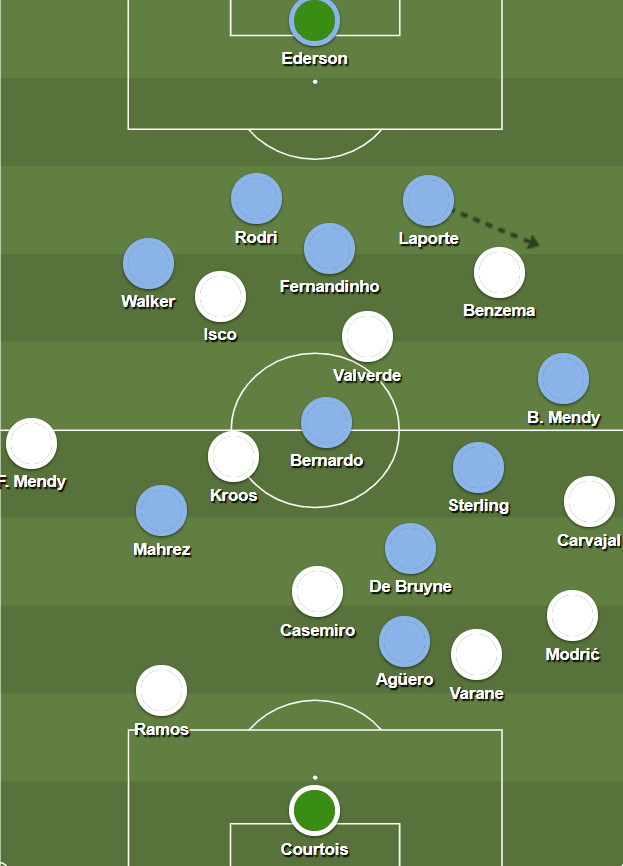
Offensively, the back three system looks more beneficial for City. In the first phase of the attack, City have technical players to move the ball as both Fernandinho and Rodri are midfielders. When we count Ederson, City have an extra man in this phase. I think it is unnecessary to play out from the back centrally, they can also build-up from the flanks through the passing triangle and the wide overload as shown below. This will create a dilemma for the Madrid full-backs: pushing forward to press or not? If they joint the press, the obviously Mahrez or Sterling can run to space behind them, if not, then City enjoy a wide overload.
Given to the individual abilities of Mahrez and Sterling, they should have given some chances to look for 1-v-1 opportunities, especially the Algerian. Since F. Mendy always push high, Mahrez can look to exploit the spaces behind him. Or, City just simply use Walker to lure F. Mendy out.
This system also gives De Bruyne freedom. If Casemiro man-marked the Belgian, City can use the dropping movements of the striker, Agüero, to distract the Casemiro. This will lead to a two-v-one against the Brazilian. If not, then De Bruyne can enjoy spaces to attack.
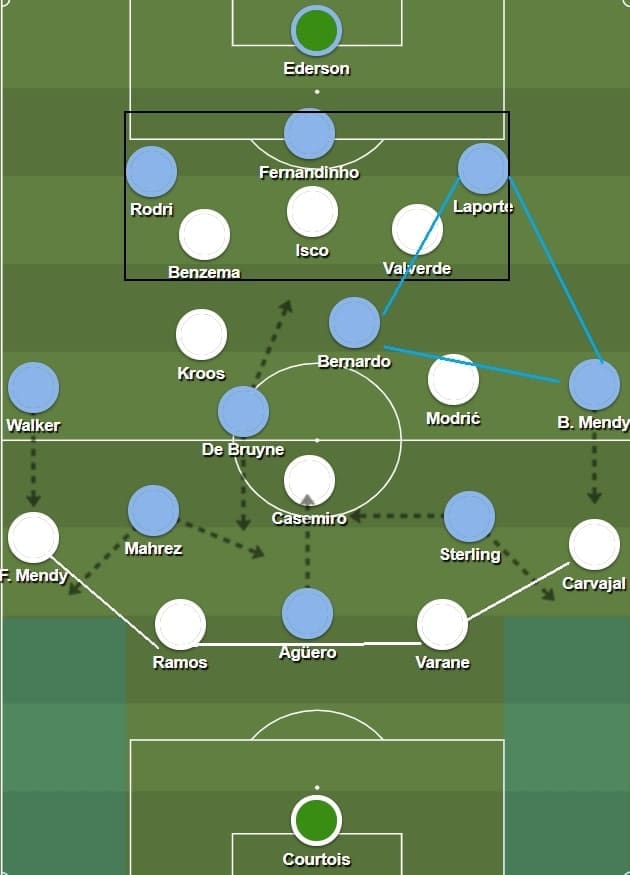
How can City attack
To further elaborate on the ideal situations in City’s attack, we use some game examples to explain. Barcelona, who also plays in a similar philosophy. Barça have one of the best sweeper-keepers, Marc-André ter Stegen in goal. In this match, they break the press of Madrid with the German’s long-kicking ability.
As shown below, the build-up phase of Barcelona invites pressure from Madrid. The Los Blancos only approach the outfield players, they neglect the keeper. This gives Ter Stegen the room to screen the pitch and pass to the front players. With the goalkeeper, Barcelona always enjoy a ‘+1’ numerical advantage in the build-up phase. Also, they cleverly use the full-backs to manipulate F. Mendy and Valverde’s position. Nélson Semedo draws F. Mendy out, set Lionel Messi free in a one-v-one against Sergio Ramos. On the other side, Jordi Alba creates an overload on Federico Valverde with Frenkie de Jong.
Ter-Stegen can find De Jong with an accurate pass, this is the moment Barcelona break the lines and facing the defenders of Madrid directly. City can try some similar routines to do this, they also have Ederson, who is good on the ball. Given to the individual ability of Mahrez and Sterling, City can pose a threat after they break the lines.
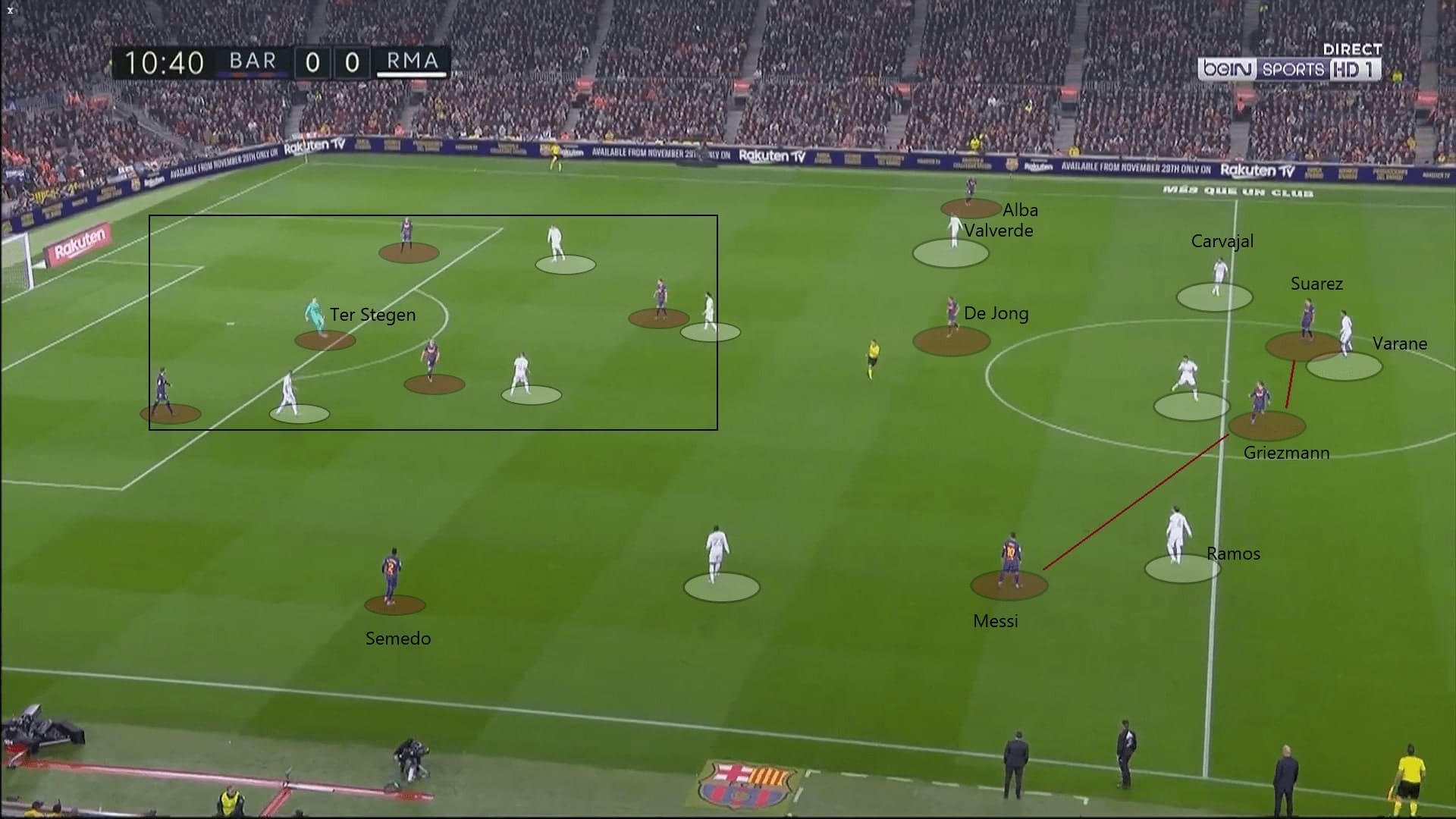
This image is another example. Both Madrid full-backs leave the defensive line and stay high because of Semedo’s and Alba’s positions. Again, a penetrating goal kick from the keeper helps Barcelona to break the lines. They generate spaces at the centre as Madrid spend numbers in their press. When Luis Suárez picks the ball, he can turn and face the goal without pressure as his partners are distracting the defenders. This is the reason that I suggest City should play with a front three and keep them high on the pitch.
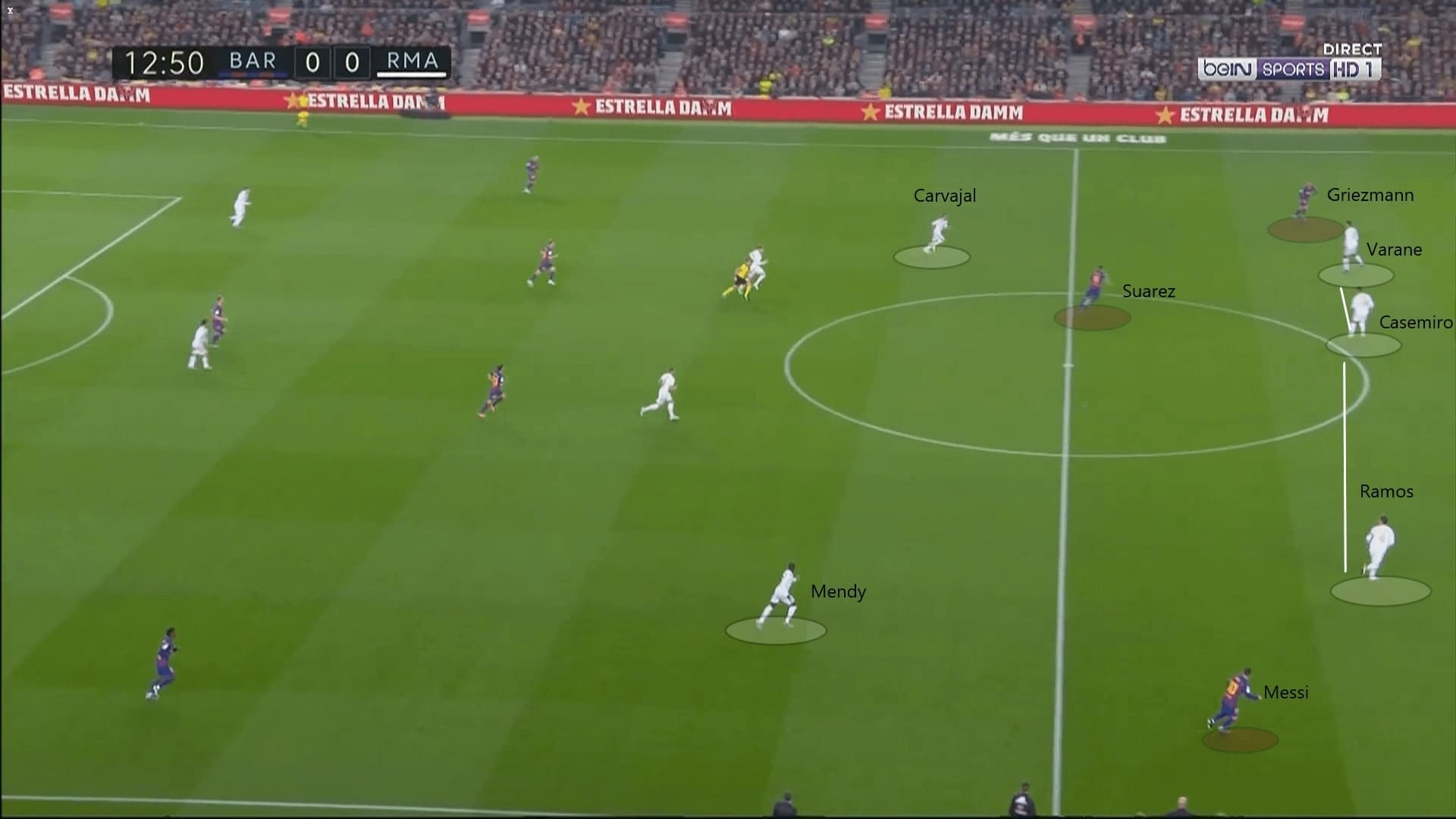
In addition, Madrid’s defensive line is unstable as their defenders tend to step out early to press. They always lose shape as a result of individual’s defensive actions. City should also prepare to exploit the gaps between defenders without hesitation.
In this case, Ramos and F. Mendy leave their positions as they try to shut the flank. However, Varane and Carvajal do not adjust their positions according to their teammates’. Álvaro Morata notices the gap and he receives a pass from Kieran Trippier. The Spaniard creates a one-v-one chance facing the keeper for himself.
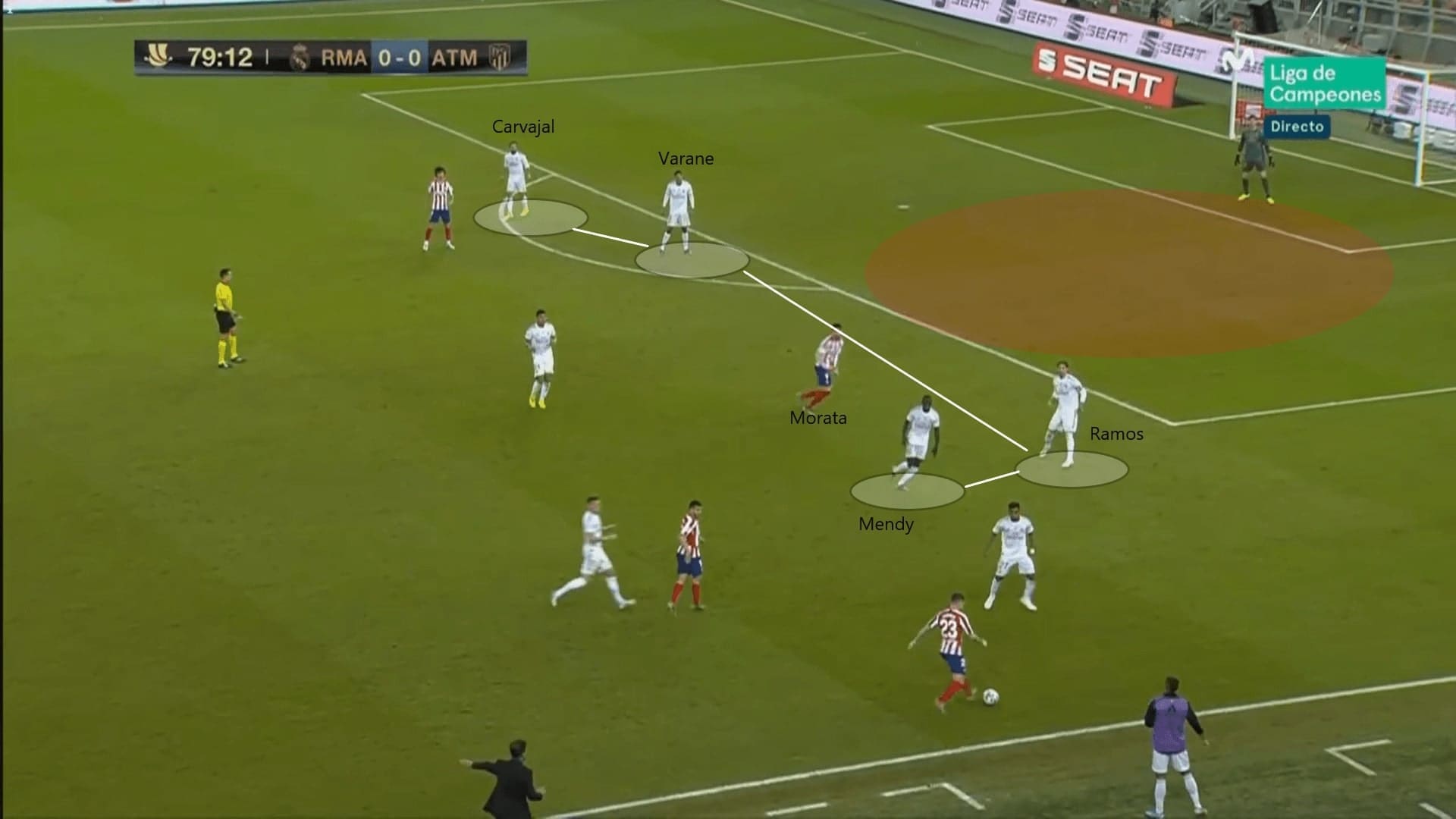
Role of De Bruyne
In this last section of the tactical preview, we want to investigate the role of De Bruyne in this game. The Belgian’s position is not fixed as given his intelligence, sometimes he is tasked to work in the attacking third. On some occasions, he stays deeper. As reflected in the below images (heat maps of De Bruyne against West Ham), in the first half, the Belgian tends to play in the final third. In the second half, he stays deeper to free himself from the markers.

Of course, Guardiola wants to get his best player on the ball. We all know what De Bruyne can offer in the final third: trademark wicked crosses, forward runs at half-spaces. On the other hand, when he stays deep, the Belgian can free from the markers and enjoy a wider angle of pass.
In this example, De Bruyne capitalize on his deep positions, which allows him to screen the pitch without pressure. He notices the gap between West Ham players and the movement of Walker. The deeper positioning also offers an opened body orientation to face the goal, in this case, De Bruyne can exercise his pass easily.
Hypothetically speaking, if Casemiro is instructed to man-mark De Bruyne, should he follow the Belgian if De Bruyne stay deep? If the Brazilian does leave his position, then his defenders are left without protection, as mentioned, the horizontal gaps between players will be exploited. If not, then De Bruyne can exercise his pass in a better angle, or even making late runs into the box in the attack.
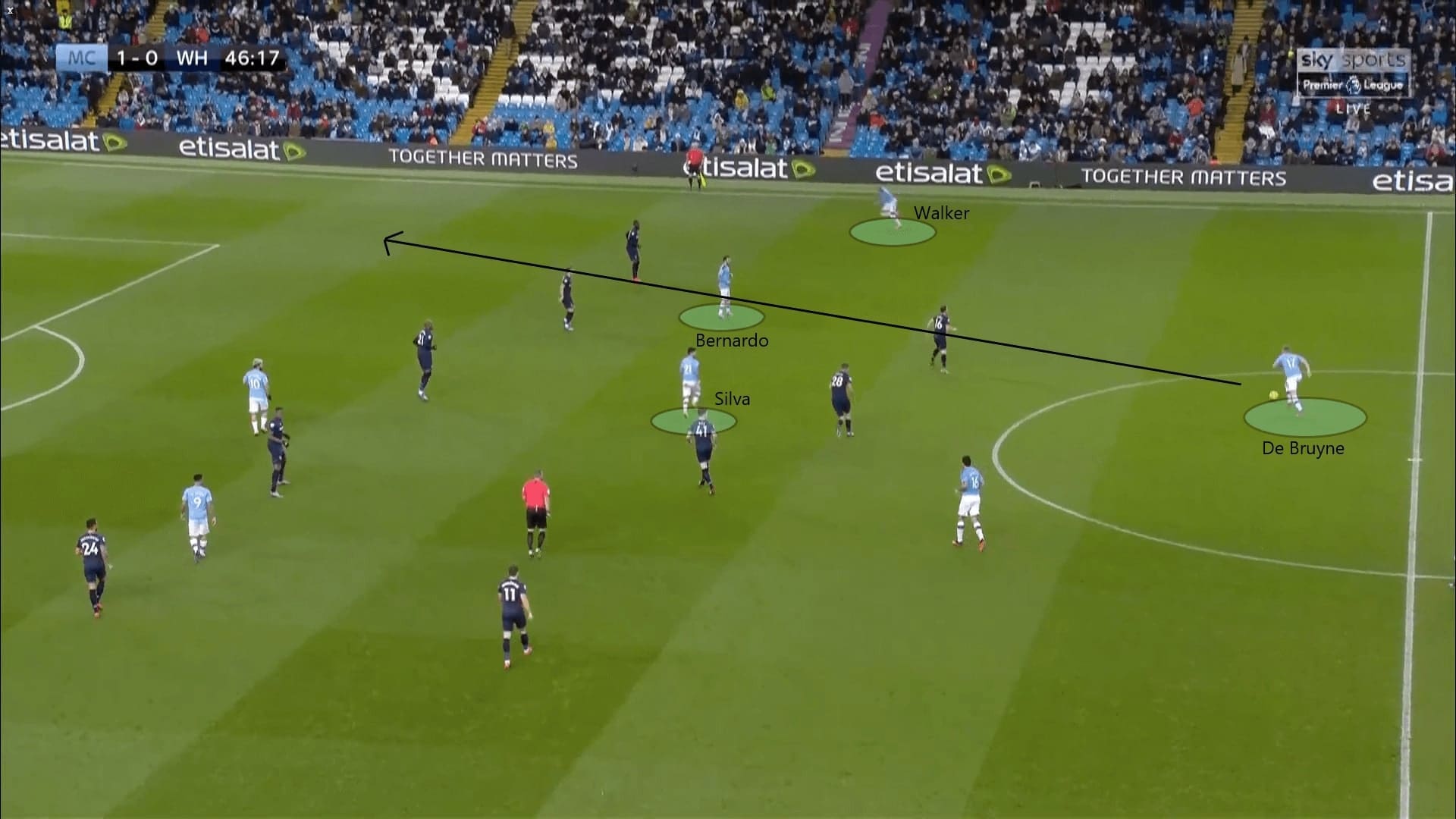
Conclusions
Despite not performing their best in the Premier League, we believe City still have quality players to challenge Madrid in Spain. The key is how to ameliorate the reoccurring weaknesses of the team and utilize their strengths. We have seen Fernandinho being outpaced in one-v-one situations or Nicolás Otamendi making silly defensive actions (both league games against Wolves). We have seen Rodri being dribbled past and staying in suboptimal positions during the build-up, which requires his teammates to instruct him. City have to avoid these events from happening in this game.
One last point to note, the Citizens have to be more clinical in front of goal. They can not repeat the history like their league games against Tottenham this season: merely convert 2 goals from 45 shots. They will have their chances, but they also have to seize those opportunities.





Comments